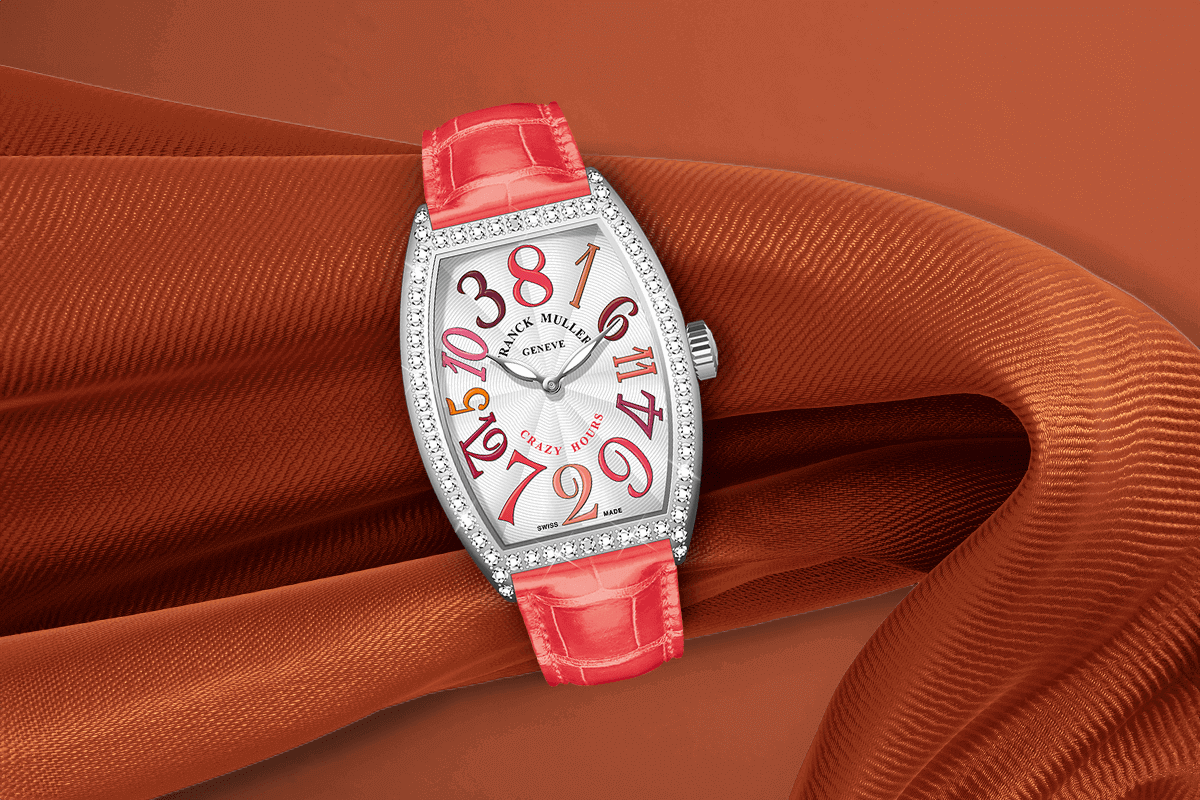
1. Cartier Clash [Un]limited
The Cartier Clash [Un]limited watch is characterised by an elegant mechanism that stands out for its beauty, creating a jewellery watch that combines finesse with power. With beads, picot studs, clou carrés and mobility, the Clash de Cartier codes flow, intertwine, forge their way and manifest themselves in the form of a precious watch.
From faceted corners and bevelled dials to full and empty spaces, as well as round and square elements, its geometry is constant and true to the Maison’s style. A culture of design counterbalanced by Cartier’s graphic precision through movement, from the beads that roll over each other to the hinges of the bracelet, all articulated to create softness on the skin.
An ambition to structure the watch and create perspective: from the form of its links to the mini case with its sixteen-faceted cut glass that accentuates the distinctive lines.
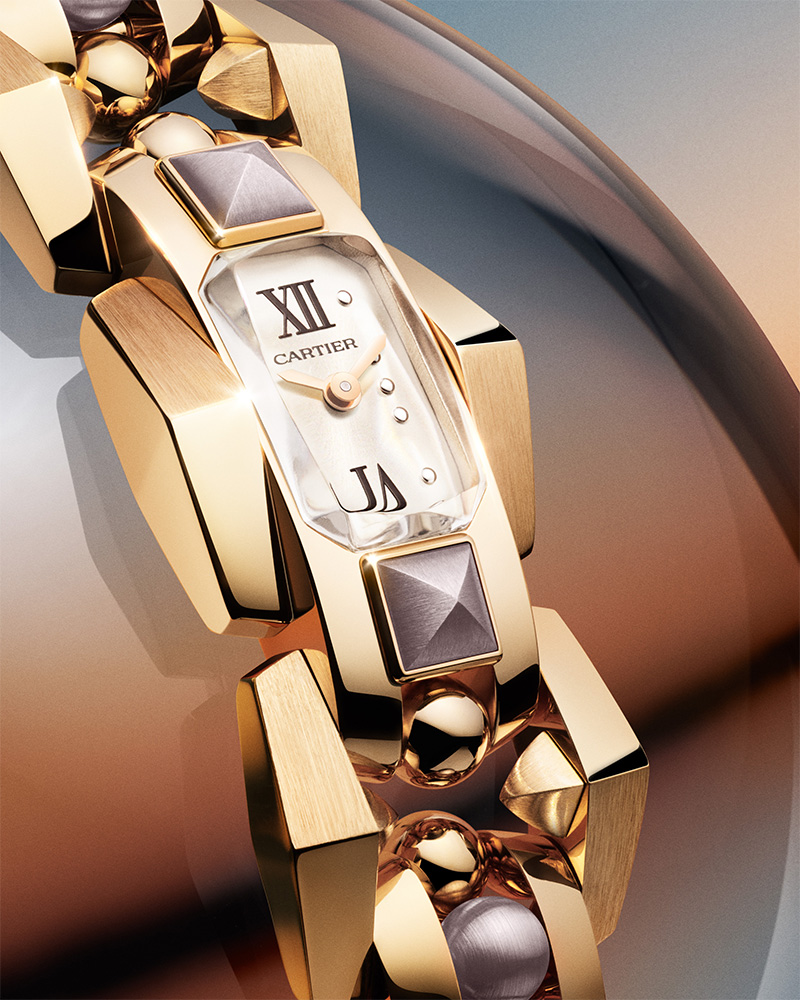
The legacy of Jeanne Toussaint and her sense of volume comes to mind. As early as the 1930s, she dared to provoke glittering collisions between preciousness and the industrial aesthetic of ball bearings. A natural link between the past and present, as seen in this Clash [Un]limited watch, which also uses chromatic contrasts to emphasise the geometric motifs.
How? Firstly, by alternating brushed and satin-finish gold, then by combining yellow or rose gold with violet gold, a new shade of gold in tones of shimmering violet, entirely developed for Cartier. It punctuates the watch, from the clou carré to the beads on the bracelet.
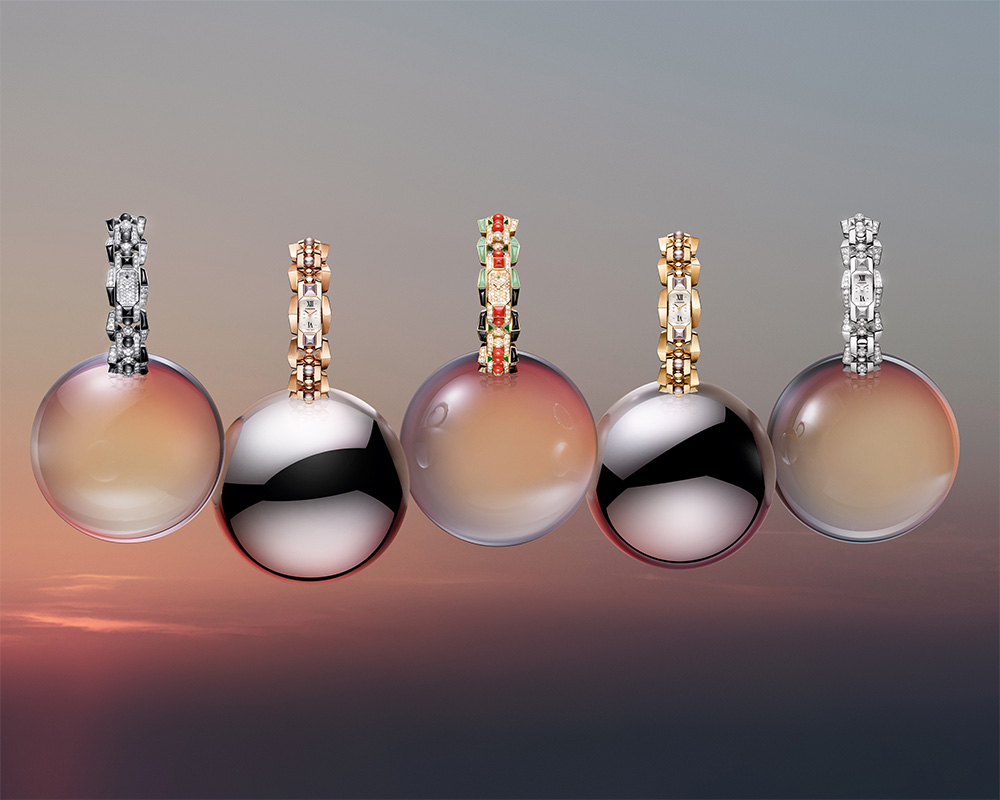
With variations on the same theme in limited-edition releases, the Clash [Un]limited watch is available in diamond-paved yellow gold, rose gold and white gold. It also unites exceptional pieces with stones that enhance the design in black and white with onyx, black spinels, obsidian and diamonds, or in different colours with coral, black spinels, chrysoprase, tsavorites and diamonds. Designed by the Cartier watchmaking studios, the Clash [Un]limited watch resides in the Maison’s creative repertoire of jewellery watches.
2. Cartier skeleton
Skeleton Watches – a cartier signature
Emblematic of Cartier watchmaking, the aesthetic of skeleton watches is based on the notions of full and empty space. Stripped of a dial, the flawless balance between the movement—which appears as if suspended in mid-air in a sculptural frame—can be clearly admired. Reflecting the creative independence of Cartier watchmaking, these pieces boast exquisite craftmanship and style.
In 2023, the Cartier skeleton is turning over a new creative leaf with the Santos-Dumont watch and its latest 9629 MC automatic calibre, developed especially for this iconic shape.
In addition to this main launch, the Cartier skeleton has also enjoyed three other interpretations: a grand complications pocket watch framed by a crystal portico and an obsidian base, a Pasha de Cartier watch with grey lacquered bridges and lastly, a Santos de Cartier watch paved with baguette-cut diamonds.
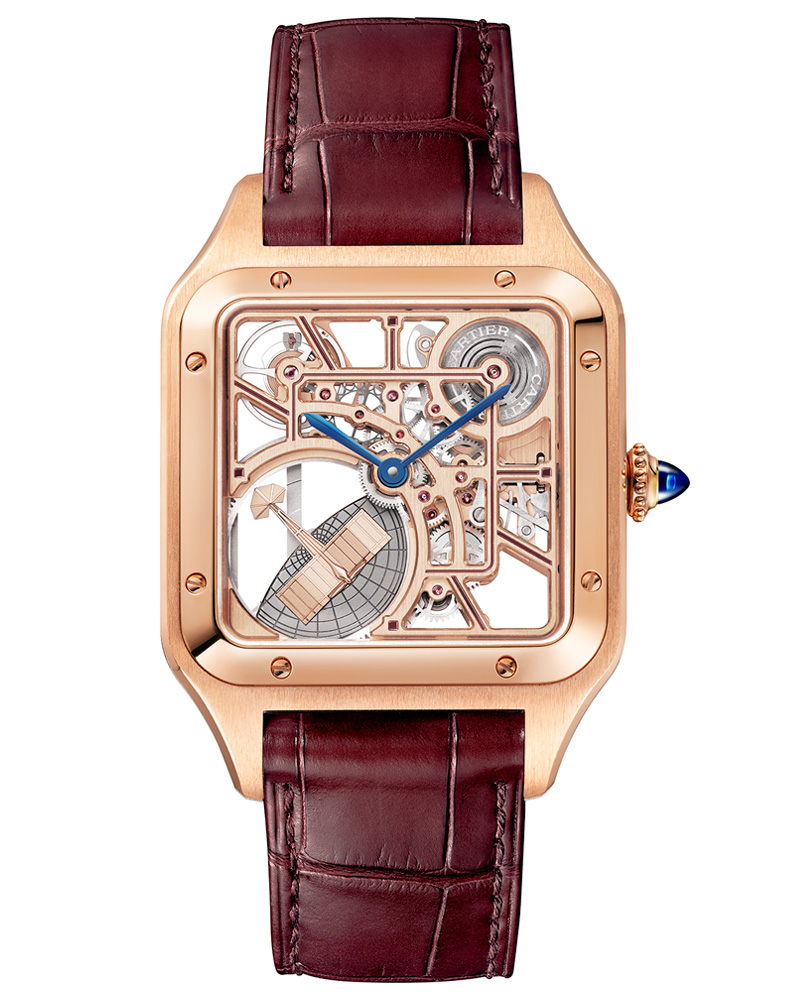
Santos-Dumont skeleton watch
Elevating the slim, understated shape of the iconic Santos-Dumont watch: this was the new challenge taken on by the Cartier Manufacture who, in 2023, is introducing a new, specially developed 9629 MC automatic skeleton calibre.
Staying true to the elegance of the original 1904 model, the legacy lives on. With a gold or steel case, visible screws, a beaded crown and blue cabochon, the latest Santos-Dumont watch—reinterpreted in 2019—features a skeleton movement, with each and every structural detail paying tribute to the aviator. Inventive and narrative, this movement includes a miniaturised functional oscillating weight in the shape of a replica of the Demoiselle, a trailblazing plane designed by the pilot in 1907. The symbol is made all the more powerful as it seems to soar over a globe.
This aesthetic and technical tribute to Alberto Santos-Dumont to is a feat of achievement, level with his own. He was a man who always aimed higher, designing more than 22 flying machines, accumulating patents for inventions and putting his life on the line during every one of his experimental flights. This new micro-rotor calibre took the Cartier Manufacture at La Chaux-deFonds almost two years to develop and is comprised of 212 components.
Made in rose gold and steel, the Santos-Dumont skeleton watch takes sophistication one step further with its limited edition in yellow gold and navy lacquer: all the details, the bezel and case are lacquered, including the skeleton bridges onto which the lacquer is applied delicately by hand.
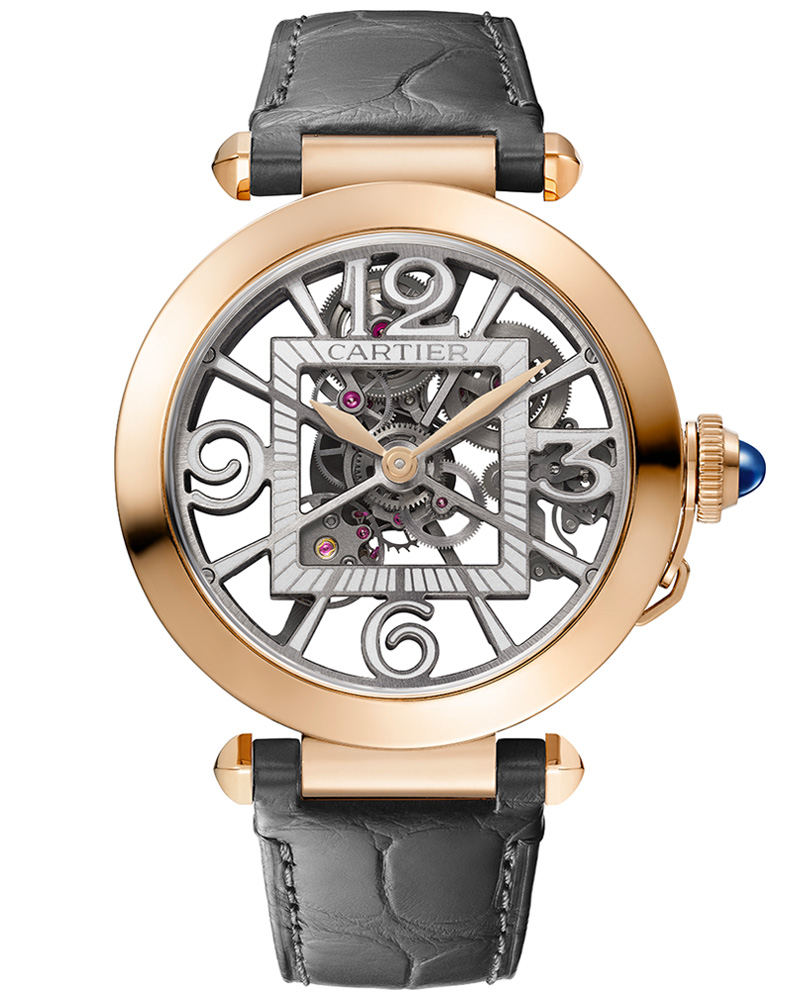
Pasha skeleton watch
For the Pasha Skeleton, Cartier adapted its signature movement to the oversized Arabic numerals of the watch. The trademark shapes of the watch, a square inside a circle, were emphasised: the square for the filigree rail track and the circle for the shape of the case.
Distinctive hallmarks and an extraordinary design for an elegant rose gold watch whose 9624 MC skeleton movement in grey lacquer heightens its presence and accentuates its depth.

Santos skeleton watch
The iconic Santos watch offers up its refined design to the combined expertise of jewellery and watchmaking. This two-pronged approach leaves its mark on the latest version, which is paved with baguette-cut diamonds and features a 9611 MC skeleton movement with manual winding.
An exercise in graphic style, each element contributes to showcasing the original square shape of the watch, with baguette-cut diamond paving and the skeletonised Roman numerals in a white gold case. A harmony of white punctuated by the presence of a winding crown, set with a brilliant-cut diamond.
The immaculate style of the timeless Santos becomes more universal than ever before, with every aspect enhanced by openwork and radiance.
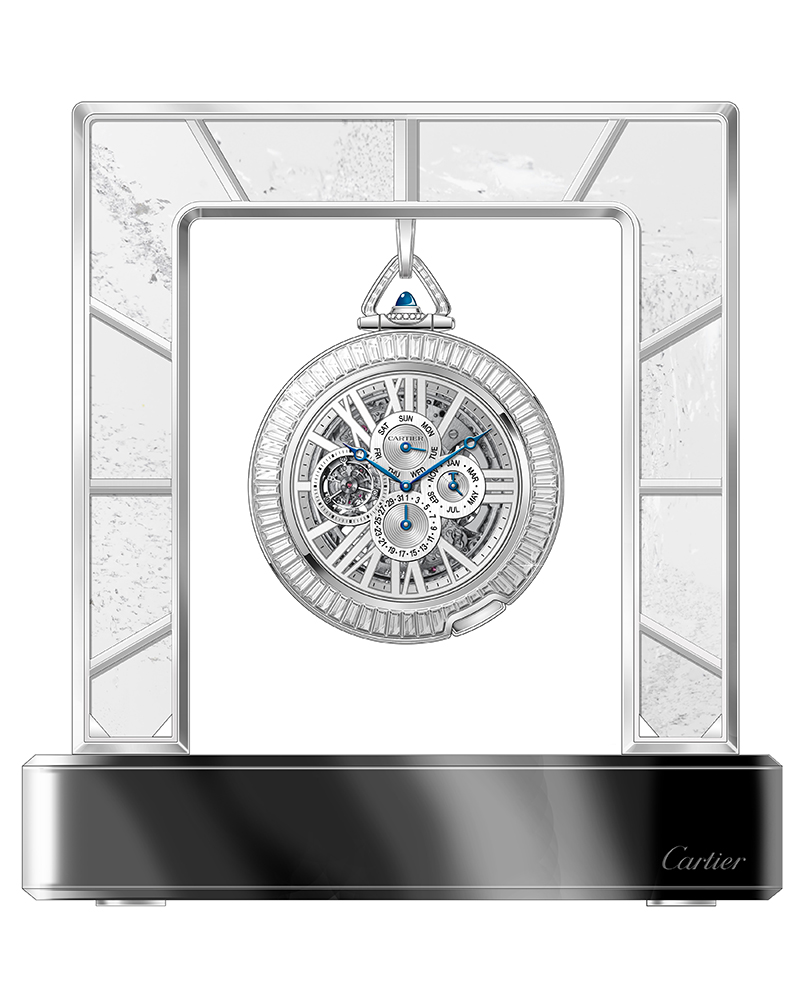
Grande complication skeleton pocket watch
9506 MC Automatic movement
Minute repeater, flying tourbillon and perpetual calendar: the Grande Complication skeleton pocket watch holds one of the most complex movements ever developed by the Cartier Manufacture. The 9506 MC automatic calibre brings together three of the most prestigious complications in fine watchmaking.
The skeletonised style of the 9506 MC calibre also allows for the beauty of the ensemble to be fully appreciated: the perpetual calendar’s counters, time, date, minutes, the flying tourbillon and finally, the minute repeater’s gongs and hammers. With a thickness of 6.77 mm and a diameter of 35 mm, this 9506 MC calibre stands out for its fineness and elegance, which honour the pure and classic aesthetic of a pocket watch.
An elegant pocket watch that Cartier presents inside a special frame, cut from rock crystal with black obsidian and white gold. This doubles its function and means it can be used as a small clock, when hung from a suspension ring designed for this purpose.
Through this watch, Cartier created a dialogue between jewellery and watchmaking savoir-faire. In a feat of collaboration, our goldsmith and enameller took turns to surround the case of the watch with a frieze of white gold gadroons and line the circumference with black enamel.
It continues the long tradition of pocket watches at Cartier, where the first pocket watches in the Maison’s archives date back to 1853. At this time, watchmaking techniques were making considerable progress. Achievements included reducing the dimensions, simplifying the mechanisms, and strengthening the resistance and reliability of small movements.
Production, assembly, calibration, casing-up: these were the challenges the Manufacture rose to, calling on all its expertise. This exceptional piece required almost seven weeks of work, from assembly to casing-up, and contains around 578 components in its grand complication calibre.
The cartier skeleton: A long tradition
A patented skeleton, the product of a long maison tradition
The Cartier skeleton acquired signature status with the creation of the Santos 100 Skeleton watch in 2009, which introduced the 9611 MC calibre; this was the first skeleton movement to be entirely designed and produced by the Cartier Manufacture.
The Cartier skeleton is now part of the identity of the Maison. Instantly recognisable by its often-sculpted bridges in the form of Roman numerals, this patented design renders Cartier the sole watchmaker capable of creating a skeleton movement whose bridges have a time-telling function. Between 2009 and 2016, the workshops of the Cartier Manufacture at La Chaux-de-Fonds created 17 skeleton movements.
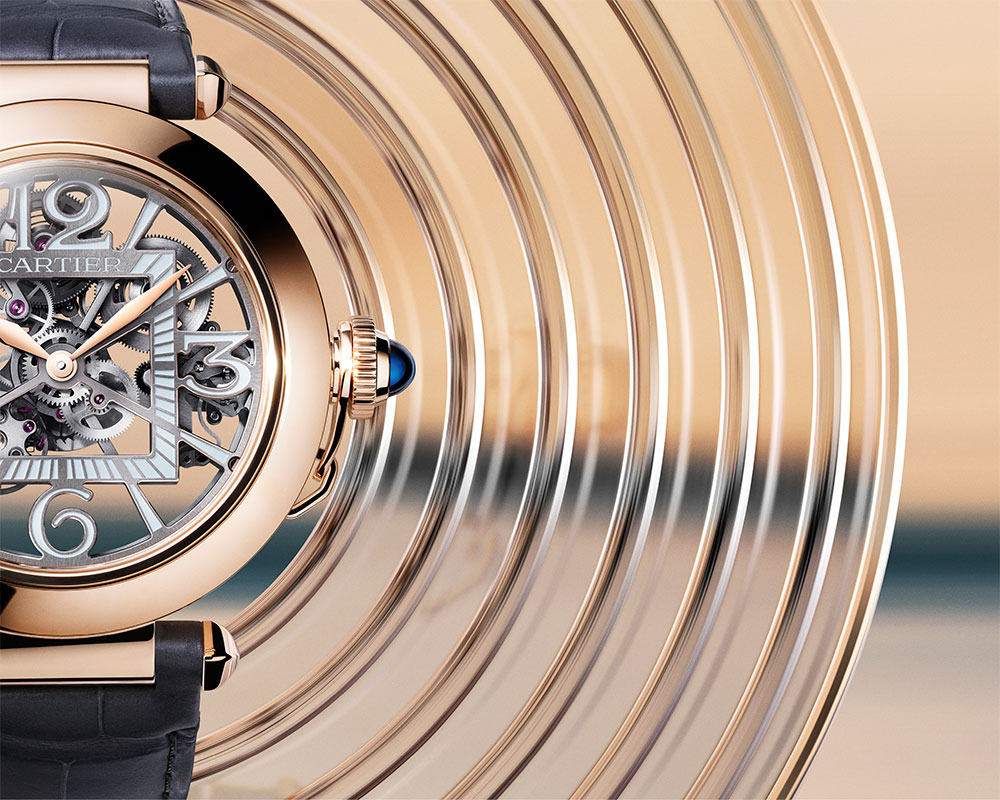
Skeleton and complications
After the 9611 MC calibre, Cartier created a series of skeleton movements with complications, rivalling the genius of the 9455 MC flying Tourbillon calibre created in 2010 with the 9461 MC Astrotourbillon calibre and the 9406 MC Grande Complication calibre in 2015.
That same year, the Cartier Privé collection highlighted the design of the Maison’s legendary watches. The Tank Cintrée and Tonneau watches were the first to be reinterpreted by the watchmaking studio, then notably the Crash watch and its 9618 MC calibre that fused with the uneven shape of the Crash watch.
Then, it was the Tank Asymétrique’s turn to enter the exclusive realm of this connoisseurs’ club. This time, the 9623 MC skeleton movement appeared in the centre of a bare structure, punctuated by the 12 and 6 cut into the top and bottom corners of the dial and the hour markers arranged in a sunray motif.
Since then, the collection has developed this movement around the rare aesthetics of the Cloche watch and the Tank Chinoise. The latter is distinguished by its rectangular shape and its bridges, which abandon Roman numerals to take the shape of a traditional Chinese motif. They are also coated in a colourful lacquer that adds a certain quality and depth.
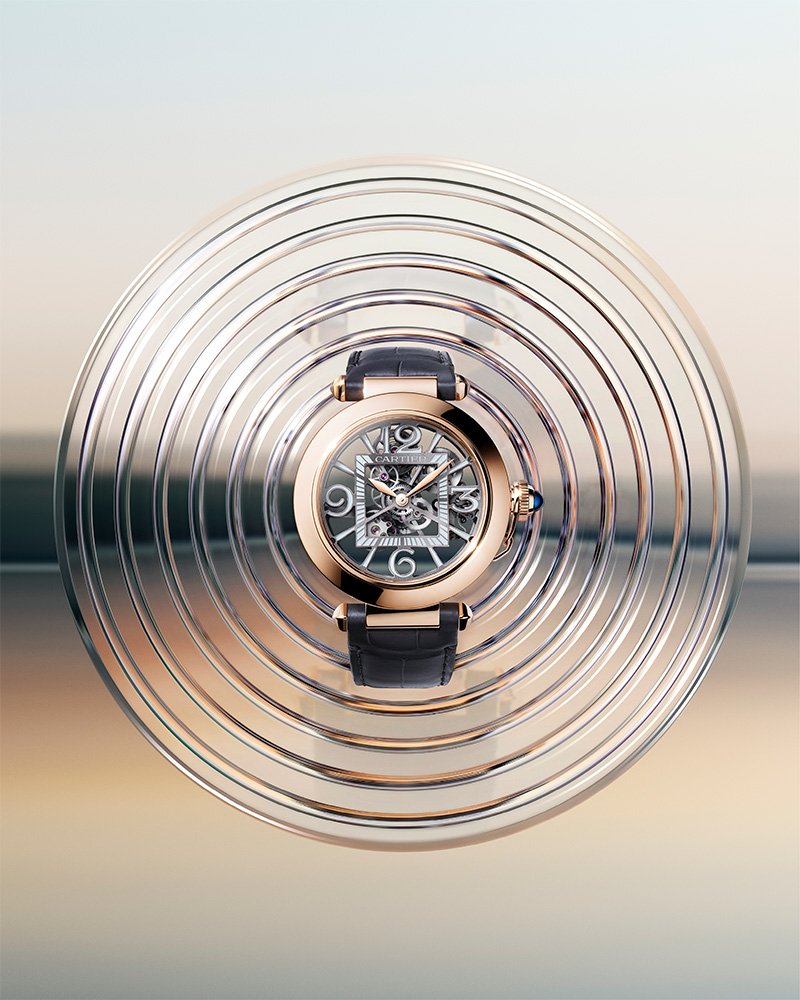
Harmony of signatures
In 2017, for the first time at Cartier, the skeleton and the mysterious movement— two of the Maison’s iconic fine watchmaking signatures—came together in the same watch. The Manufacture perpetuated the technical and aesthetic harmony of this exceptional match in 2022 with the development of an extremely complex piece: the Masse Mystérieuse watch, which again combined the mysterious movement and the skeleton.
A watch that turns to the rhythm of the new 9801 MC moving calibre, condensed into a semi-circle and transformed into a skeleton oscillating weight.
The new 9801 MC calibre ensures the effects of gravity do not affect the chronometer. The result of nearly eight years of work at the Cartier Manufacture, where it was designed, developed and assembled, a patent has now been filed for this movement. On the Masse Mystérieuse watch, the hands float in the space of the case, without being connected to any gears. Even better: the whole movement seems weightless.
All components that receive energy from the movement, transmission and regulation are integrated in the rotor. The rotor itself is skeletonised to make this moving spectacle visible. In the centre, an ultra-sophisticated differential system borrowed from the automotive industry has been integrated into the movement to prevent the time display from being caught in the mass.
A technical feat that comes to life at the slightest motion of the wearer and seamlessly displays the time to the rhythm of the hands in the void. On this piece—the most technical and complex piece ever developed by the Manufacture’s watchmakers—the mysterious rotor uses an innovative principle that ensures the balance wheel always remains in the same vertical position. For this to happen, the rotor rotates in both directions at an irregular speed.
3. Santos de Cartier and Santos-Dumont
Santos And Santos-Dumont
Modern before its time, it favoured—when created in 1904— simplicity, practicality and innovation, three main principles dear to pioneering aviator Alberto Santos-Dumont. It was for Santos- Dumont that Cartier created a wristwatch so he could read the time whilst flying, without having to let go of the controls to check his pocket watch.
Collections
Its unique shape, attention to detail and precise proportions meant it could evolve with the times; today, two new interpretations have been designed.
On the one hand, the elegant Santos-Dumont watch that refines the appearance of its Roman numerals with hard stones and on the other, the innovative Santos de Cartier watch that explores colour.
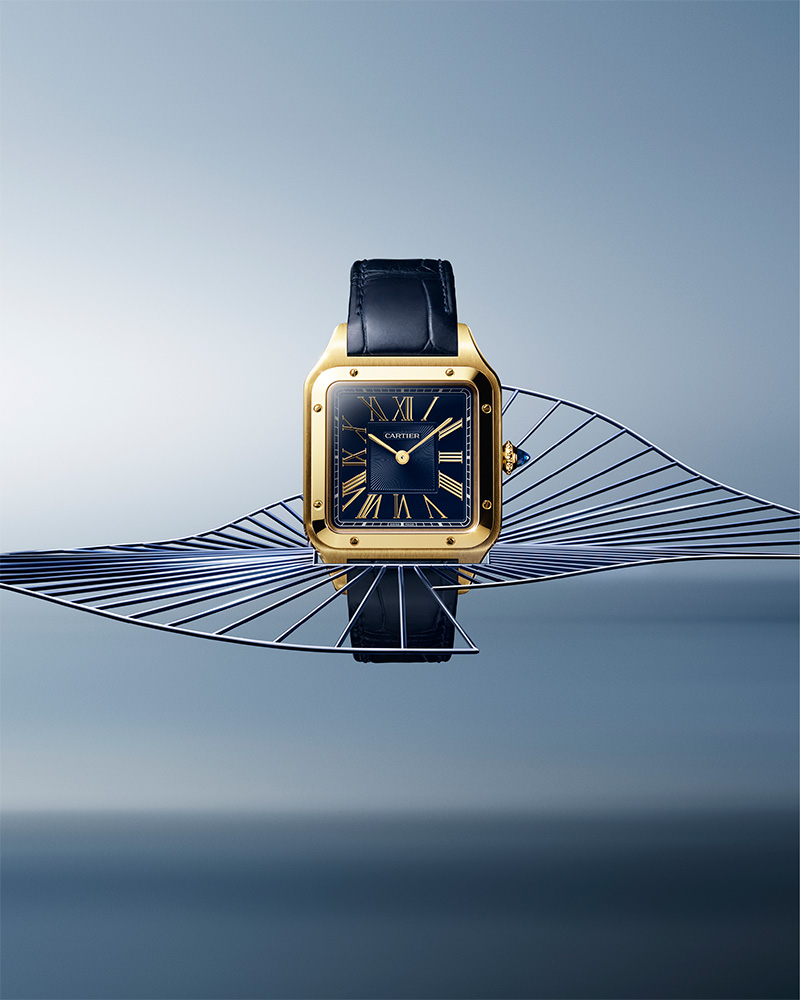
Santos-dumont watches
As a tribute to the historical model, the Santos-Dumont collection adds five new versions to its elegant repertoire.
Three watches in platinum, rose gold and yellow gold that elevate their dial with Roman numerals cut directly in jasper, jade and dumortierite: three colours that match the cabochon on the winding crown of the watch. Finely worked, these delicate Roman numerals are enhanced by the depth and rays of the dial’s guilloché effect. They showcase the originality of this limited edition, equipped with a 430 MC mechanical movement with manual winding.
Two watches in grey or deep navy blue. With a flawless dress code, these guilloché dials boast contrasting gold hands and Roman numerals. In yellow gold or yellow gold and steel, this sophisticated version of the Santos-Dumont watch cultivates an art of elegance that is entirely its own.
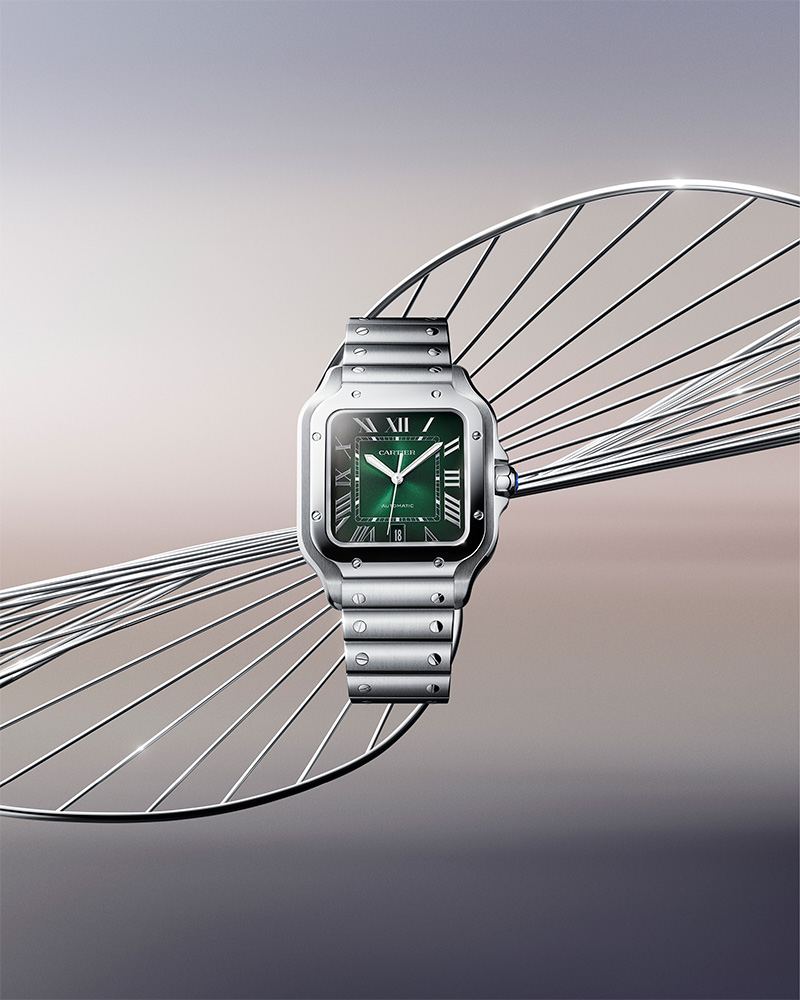
Santos watches
With tapered lines and optimal ergonomics, the Santos watch is a leading icon of Cartier’s design culture. An emblematic collection in a constant state of renewal, Santos allows for the most audacious colour in its all-steel version.
The Bold Colours Of The Santos Watch
In addition to the navy blue, Cartier has expanded its chromatic spectrum and dared to include deep green. This is the mantle taken up by these new versions, whose iridescent dials radiate with graduated colours and a metallic shine. Everything is coated in a thin layer of tinted lacquer, applied by hand. Its finesse and transparency bring lustre, texture and depth to the colours.
Available in two sizes, large and medium, all the watches are equipped with an 1847 MC automatic movement and two interchangeable straps in steel and alligator, which can be easily swapped thanks to Cartier’s patent-pending QuickSwitch system.
4. Cartier Jewellery Watches
Using the emblematic shapes of the Maison’s watchmaking repertoire — the rectangle of the Tank and the oval of the Baignoire — Cartier shakes up the codes and brings together all that is precious and rare to create watches that celebrate the Maison’s expertise. Watchmaking and jewellery become one in a blend of expertise and formal exploration.
A Jewelled Tank Watch
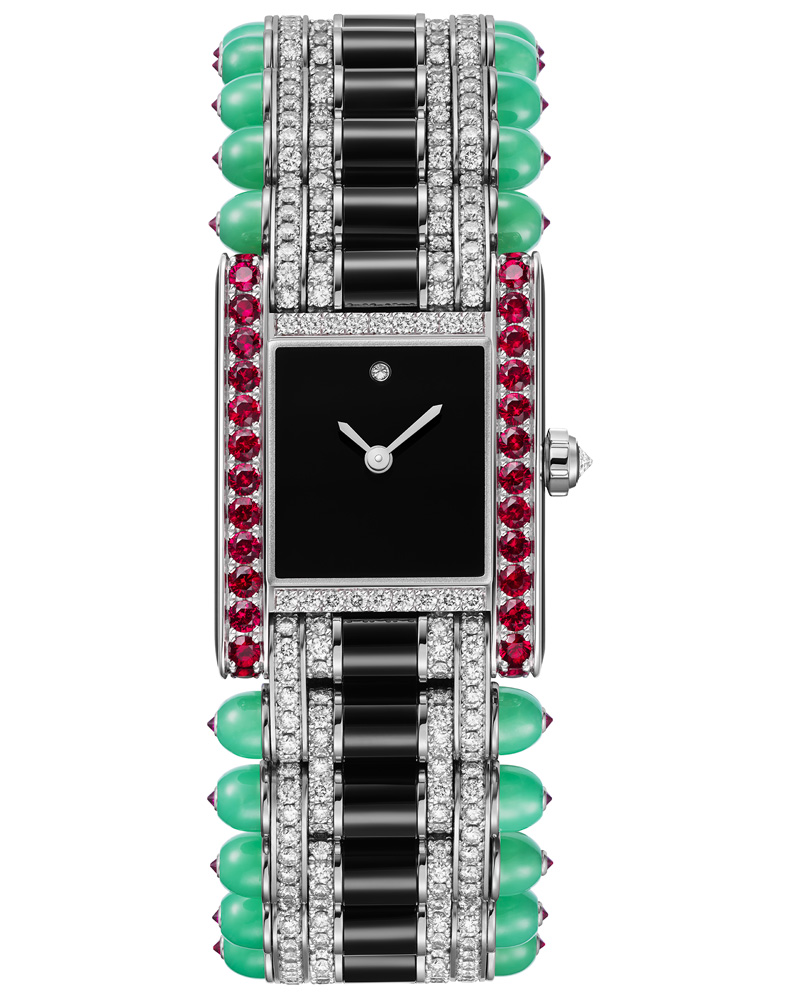
Sharp And Round
Created in 1917, the Tank watch is an emblematic creation of modern design. Its rectangular dial, aligned with the strap, has become a signature. It is this watchmaking icon that Cartier has chosen to explore through the prism of geometry and contrasts — a signature marker of style for the Maison that is based on shapes and patterns, working from effects of symmetry or asymmetry and powerful chromatic contrasts.
The imprint of the original watch is still present on this new Tank: two parallel brancards, a rectangular case and the bracelet that fits seamlessly integrated into the case.
However, on this occasion, this distinctive attachment of the Tank watch secures a flexible bracelet, entirely composed of mobile cylinders articulated by links.
Promising flexibility and comfort, it invites touch and movement. The different aesthetics of this new creation share a common characteristic: their bracelet — composed of cylinders in onyx, chrysoprase or coral — is finished with a cabochon studded with a gold nail and a reverse set stone. This is Cartier’s way of paying tribute to the piqué beads used by Jeanne Toussaint, a major figure in the history of the Maison and Cartier’s creative director from 1933. A Cartier signature.
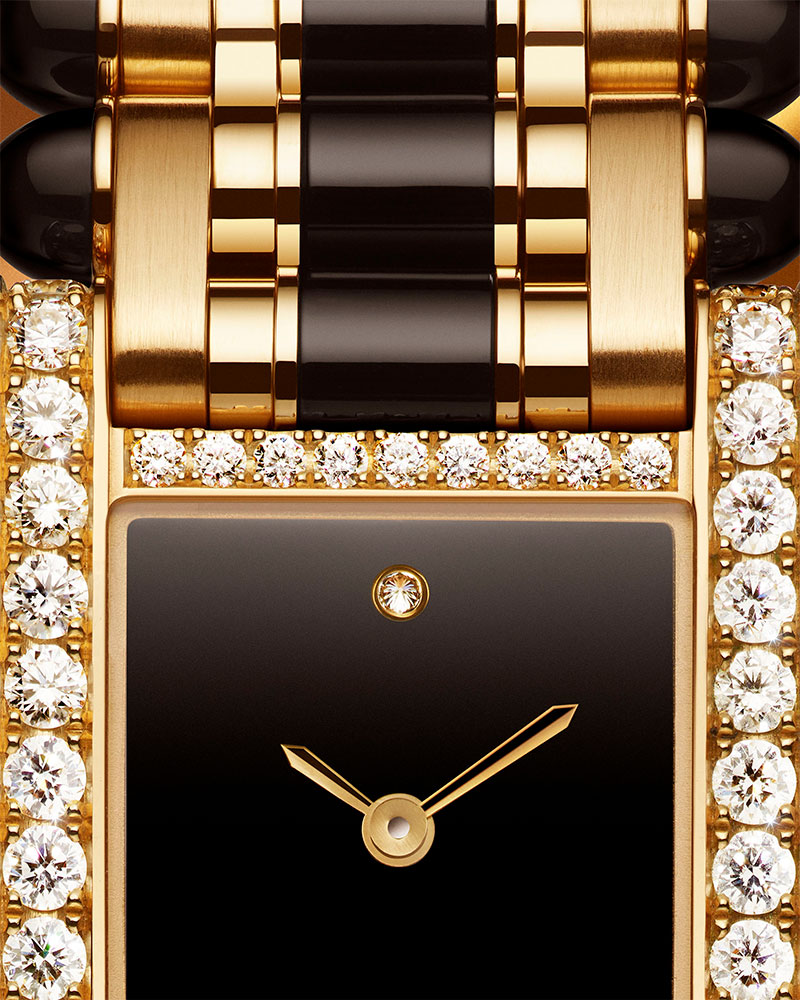
Variations On Gold
An elegant and classic accord for a watch with a black onyx dial, illuminated with a diamond on the index. The brancards, set with diamonds of different sizes, form the structure of this creation and extend to join the precious bracelet created from enamel and onyx cylinders, the ends of which are illuminated by a gold nail set with a diamond.
Chromatic Exploration In The Footsteps Of Jeanne Toussaint
For this new Tank watch, Cartier has come up with two even more precious variations that combine the beauty of the design with the brilliance of coloured stones to revive a colour palette borrowed from Jeanne Toussaint.
Black, green, red: three colours cherished by Cartier for a white gold watch. An interplay of contrasts and pairings: black, like the onyx of the cylinders, the edge and the dial, contrasting with the acid green of the chrysoprase beads and the red of the rubies set along the vertical brancards and the nails at the end of the chrysoprase cabochons.
Coral, chrysoprase, amethysts and diamonds: this combination of stones is a continuation of Cartier’s exploration of materials, which has become the Maison’s signature. An upbeat and joyful combination for this precious watch featuring a dial paved with snow-set diamonds.
On the rolls, the chrysoprase contrasts with the organic vibrancy of the coral studded beads and the softness of the amethysts set on either side of the chrysoprase. Vertical and horizontal brancards, edges and bracelets: the diamonds illuminate the ensemble with the brilliance of different sizes.
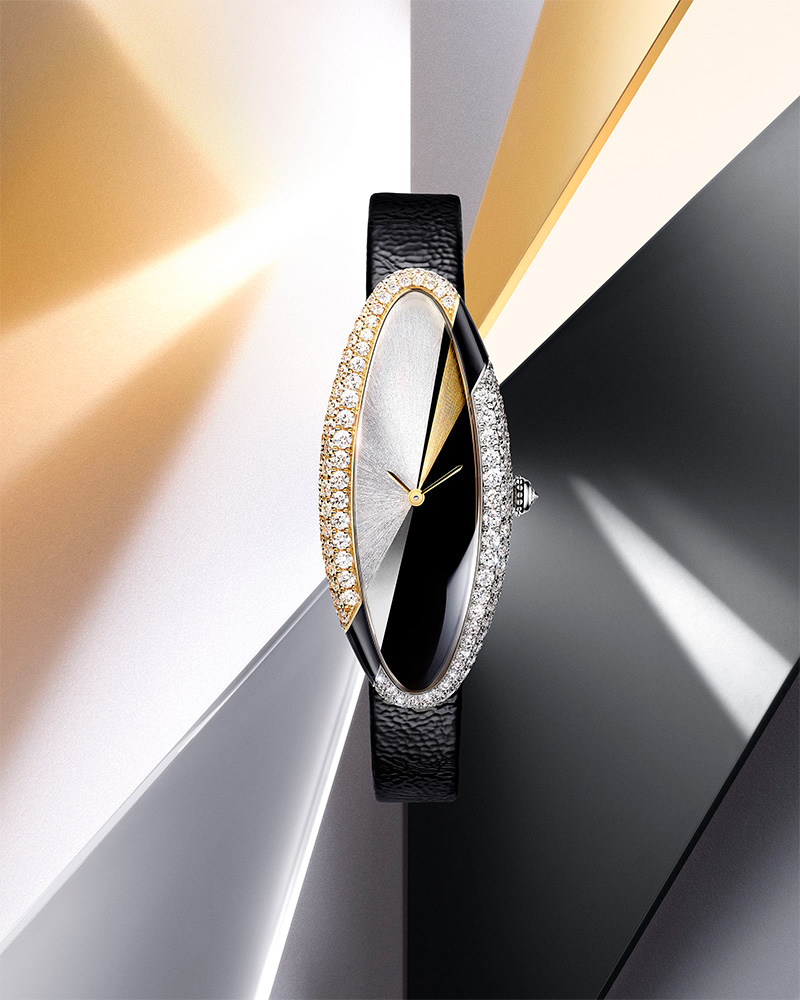
The Baignoire Allongée Craftsmanship
Created in the 1960s in Swinging London, the Baignoire Allongée watch has never lost its extravagance — quite the contrary. This watch was made singular by the size of its dial and the curves of its case. Cartier explores all possibilities and, for the first time, brings the beauty of its craftsmanship to the realm of its signature dial. This choice is based on a strong principle at Cartier: technique dedicated to design.
This vision gives the designer the freedom to experiment with creativity and dare to combine bold shapes with unexpected combinations of colours and materials. To make this dream a reality and meet these new challenges, the artisans from the Maison des Métiers d’Art design appropriate solutions based on the wealth of their expertise. An imperceptible mastery, and a constant emphasis on precious details.
Geometry And Contrasts
The new Baignoire Allongée was developed with the intention of revisiting the aesthetics of a watch with character through the prism of geometry and contrasts — one of the Maison’s markers of style.
By adapting this creative principle to the constraints of the watch design (large dial, curved shape), the task becomes even more difficult, as the case designed in two colours presents a technical challenge. The solution is a case composed of two parts, one in yellow gold and the other in white gold. To combine them, the watchmakers used a micro-welding tool. The margin between the two golds is subtly concealed by a line of lacquer.
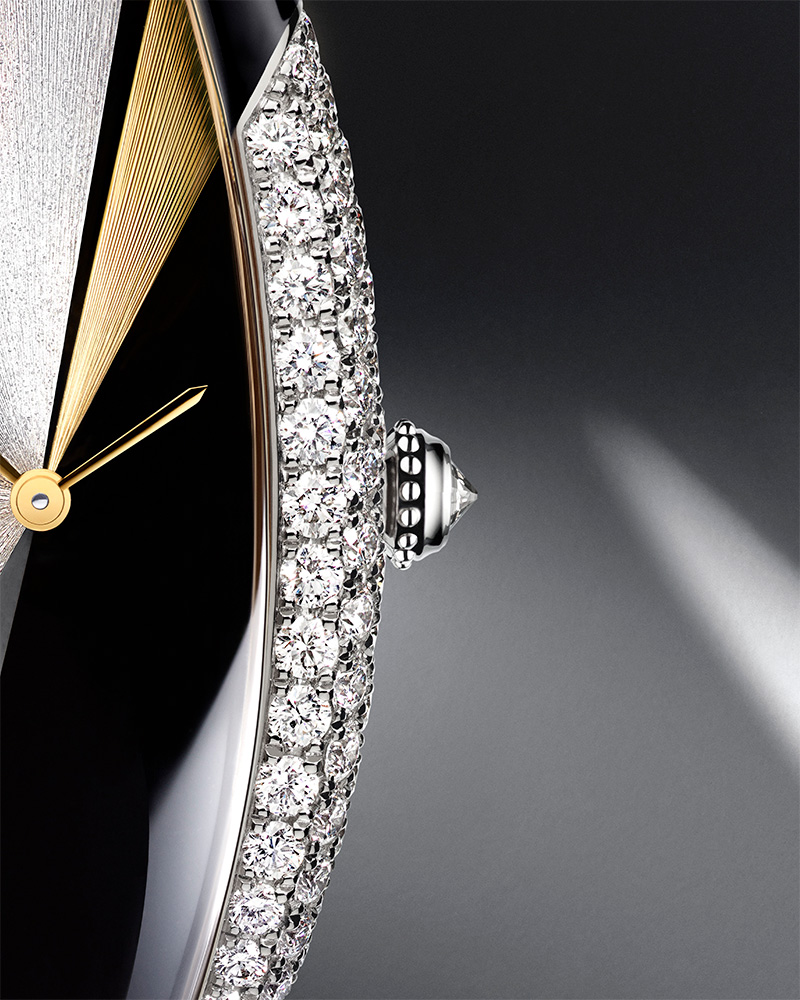
The whole dial is divided into sections of different sizes, the gold of which is either worked or covered with black lacquer or enamel. The white and yellow gold sections are polished or adorned with a sunray motif made by hand with the use of a spike — a meticulous and time consuming process that takes four hours per dial.
Some sections are then coated with a translucent lacquer illuminated with suspended mica flakes. For the black lacquered or enamelled parts, the curve of the dial poses a technical challenge during installation in terms of achieving a smooth surface with an intense colour. This contrasts with the diamond-lit case, the setting of which follows the curve of the piece.
From machining to enamel, lacquering to jewellery making, nine different areas of expertise are involved in the creation of each piece. In total, it took more than 24 months to create this watch.
A creation featuring an abstract motif that sublimates the art of craftsmanship through a new exploration of materials, colours and geometry, this watch is available in a limited series of 50 pieces.
Miniature Marquetry For An Oversized Baignoire
Cartier introduces the art of marquetry to the heart of the dial on the Baignoire Allongée watch. A rare craft, adapted to watchmaking, which gives rise to a watch with an abstract motif that celebrates colour.
From the outset, the Baignoire’s bezel is surprising, with its diamond-set material, grey spinels and blue tourmalines in an inverted pavilion setting. There exists a strong play of contrasts between the aesthetics of the watch, with its curves and roundness, the size of its dial, and the sensual nature of the gemstones. The complexity of the inverted pavilion setting increases the usual manufacturing time by 20%.
On the dial, mother-of-pearl, turquoise, onyx and white gold create an abstract composition, playing with both shiny and matte colours. Carefully selected for a harmony of colours, the fine materials are then laser-cut into miniature elements to be assembled like pieces of a puzzle. All of these meticulous steps are carried out with a binocular microscope. Performing this marquetry work on a curved surface is a challenge for the artisans and each dial requires 25 hours of work.
Four different types of savoir-faire are involved in the creation of this watch: the jeweller, the marquetry craftsman, the setter and the watchmaker. This watch is available in a limited series of 50 pieces.
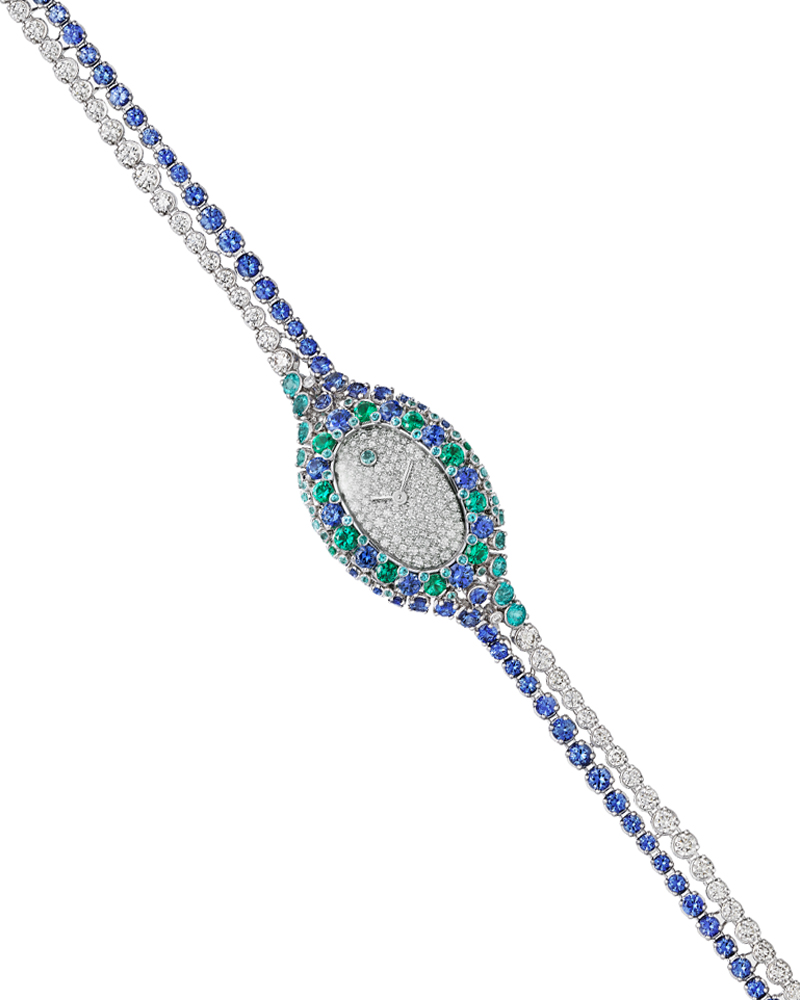
Jewelled Baignoire
The Baignoire watch is part of the research initiated by Louis Cartier on watchmaking shapes from the very beginning of the 20th century. Following the Santos de Cartier with its square case in 1904 and the Tonneau in 1906, it was in 1912 that the first oval watch appeared in the company’s repertoire. It would go on to evolve over the following decades, and it was not until 1973 that a watch was named “Baignoire”, meaning “bathtub”, in reference to the refined shape of an everyday household object. Cartier’s own vision casts light on beauty in all its guises. Always true to itself, the Baignoire has known multiple transformations since its creation. Like endless possibilities to which Cartier gives form, it follows a pattern of continuity while resembling only itself each time.
A watch that is constantly reinventing itself, as proven by this new collection of evening watches that gives Cartier the opportunity to explore different forms. Two new versions and two variations in scale underline this jewelled Baignoire that celebrates and sublimates the distinctive diamond line.
A double or triple line that enhances the curves of the watch and slips onto the wrist. Cartier envisions it entirely in diamonds or paired with sapphires, emeralds, chrysoprase or blue tourmalines. On a delicately arched structure, the snow-set dial features a paving in which the metal appears to be completely absent: the stones of varying cuts create a vibrant and shifting appearance. This radiant wave continues at the wrist, underpinned by a sequence of different sized stones. Like an explosion of coloured lights, it gives the watch spontaneity and flamboyance.
5. Cartier Privé
Each year, a rare watch joins Cartier Privé, the collectors’ collection that celebrates and explores the Maison’s mythical models through limited edition and numbered watches. These unique and sought-after watches bridge the gap between Cartier’s watchmaking heritage and their contemporary aesthetic vision. Today, Cartier Privé reveals its 7th opus: the Tank Normale, which takes its place alongside the Crash watch, the Tank Cintrée, the Tonneau, the Tank Asymétrique, the Cloche and the Tank Chinoise. Made in 1917 by Louis Cartier and sold two years later, the Tank is one of the most remarkable creations of the Maison and indeed in the history of watchmaking. Its meticulous design and pure lines have made it an eternal watch capable of transcending time.
This year, Cartier has dreamt up an hour/minute version that borrows the proportions and bevelled sapphire crystal of the original. It comes in yellow gold with a brown alligator strap and in platinum with a black alligator strap. A first for the Cartier Privé collection, it is also available with a yellow gold and a platinum bracelet, with contrasting satin and polished finishes in a clear nod to the 1970s. The case and bracelet appear as one with their satin finishes. This continuity is juxtaposed against the polished finish, which highlights the outlines of the brancards and the edges of the case.
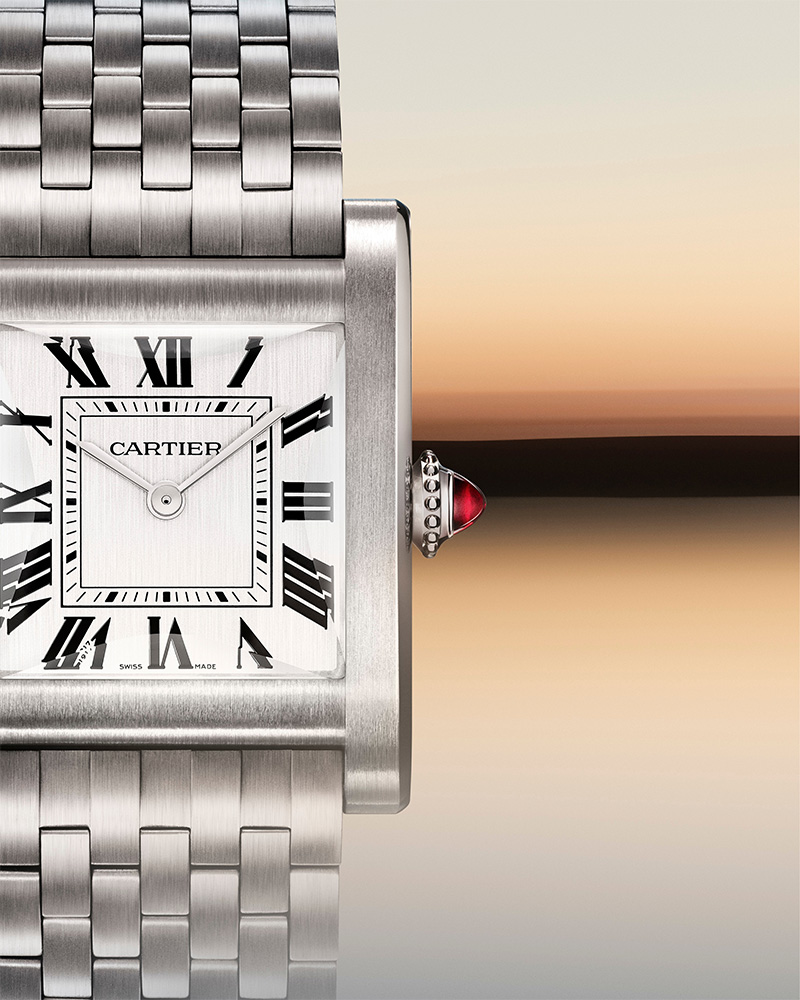
To this iconic shape in the Maison’s watchmaking history, Cartier adds one of its signature complications with a skeleton movement. It also features a 24-hour complication marked by a sun and crescent moon, also skeletonised. While the minute hand turns around the dial in one hour, the hour hand goes round in 24 hours instead of 12 hours. As a result, daytime hours appear on the upper part of the dial and night-time hours appear on the lower part. To symbolise the transition from day to night, watchmakers have coated the skeletonised bridges with a gradation of shades adorning the two halves of the dial.
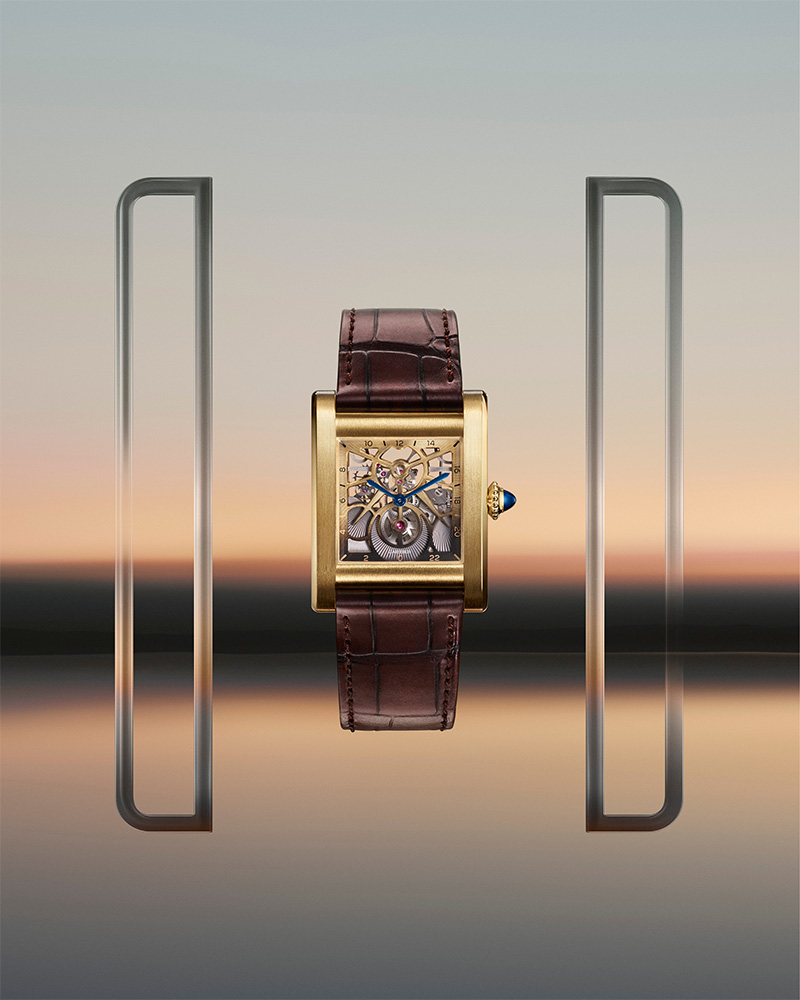
A limited edition of 50 numbered watches, this skeletonised Tank comes in yellow gold on a brown and green alligator strap with a blue sapphire cabochon on the winding crown and in platinum on a burgundy and grey alligator strap with a ruby cabochon on the winding crown. A watch with a case set with brilliant-cut diamonds completes the ensemble, in a limited edition of 20 numbered pieces, featuring alligator straps in two shades of blue with a brilliant-cut diamond on the winding crown.
Hallmarks of the original Tank can be found throughout all these variations: blued hands, a cabochon on the winding crown and, on the simple Tank Normale, rail tracks and a secret signature – countless signs that this collector’s watch is right at home in Cartier Watchmaking.
6. Cartier Tank
Tank collection
For Cartier, it all starts with the design. An uncompromising feature. Clean and precise lines. The Tank watch is the epitome of this pursuit of purity. The intelligence of its design places it seamlessly within its time as well as securing its future. Its capacity to evolve is inexhaustible. Tank is also a family, featuring the Tank Américaine, the Tank Française and the Tank Louis Cartier. Three watchmaking icons that Cartier dares to evolve with the times.
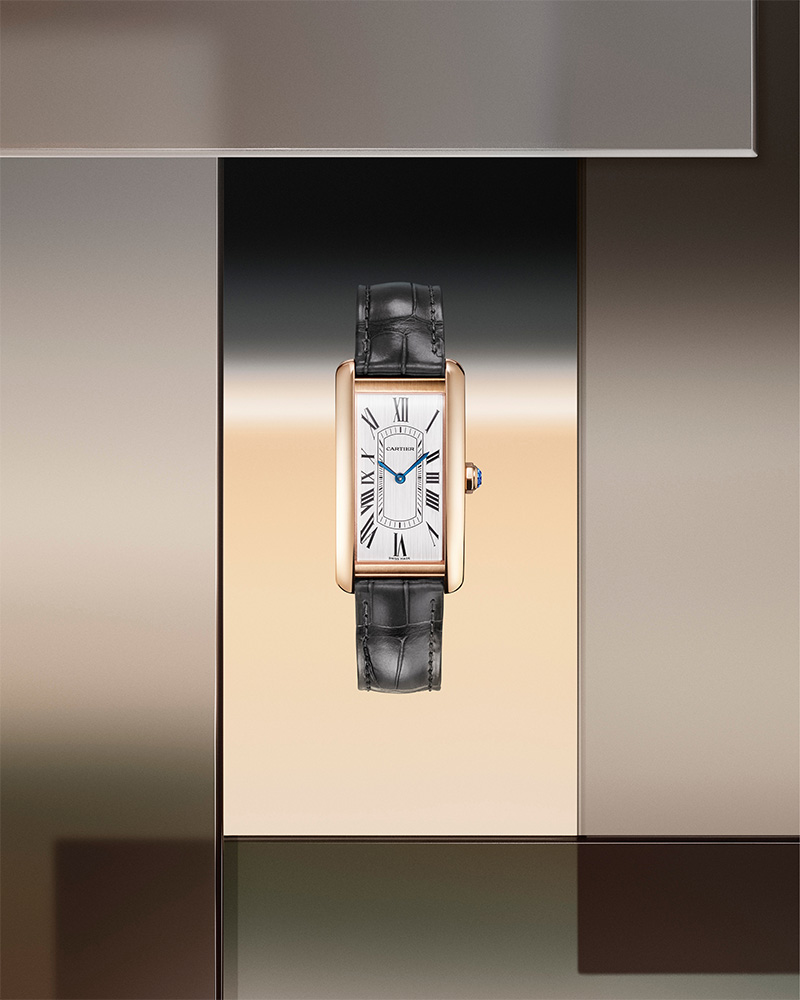
Tank Américaine
Launched in 1989, the Tank Américaine drew its inspiration from the Tank Cintrée watch, from which it borrowed its curved case. At the same time, the Tank Américaine watch introduced the first adjustable strap partnered with the famous folding buckle, for which Cartier filed a patent in 1910.
In 2023, the Maison’s design studio is reinforcing the original design of the watch and its curved shape by carving a finer, more acrobatic line. The purity of its form is further reinforced by the style of the dial and the flawless integration of the brancards into the extension of the strap.
Equipped with the new 1899 MC movement for slimmer cases, the Tank Américaine watch comes in all-gold and steel with a leather strap, rose gold and diamonds with a leather strap or diamond-paved white and yellow gold with a metal bracelet. Designed especially for the Tank Américaine, its links feature polished facets that catch and radiate light.
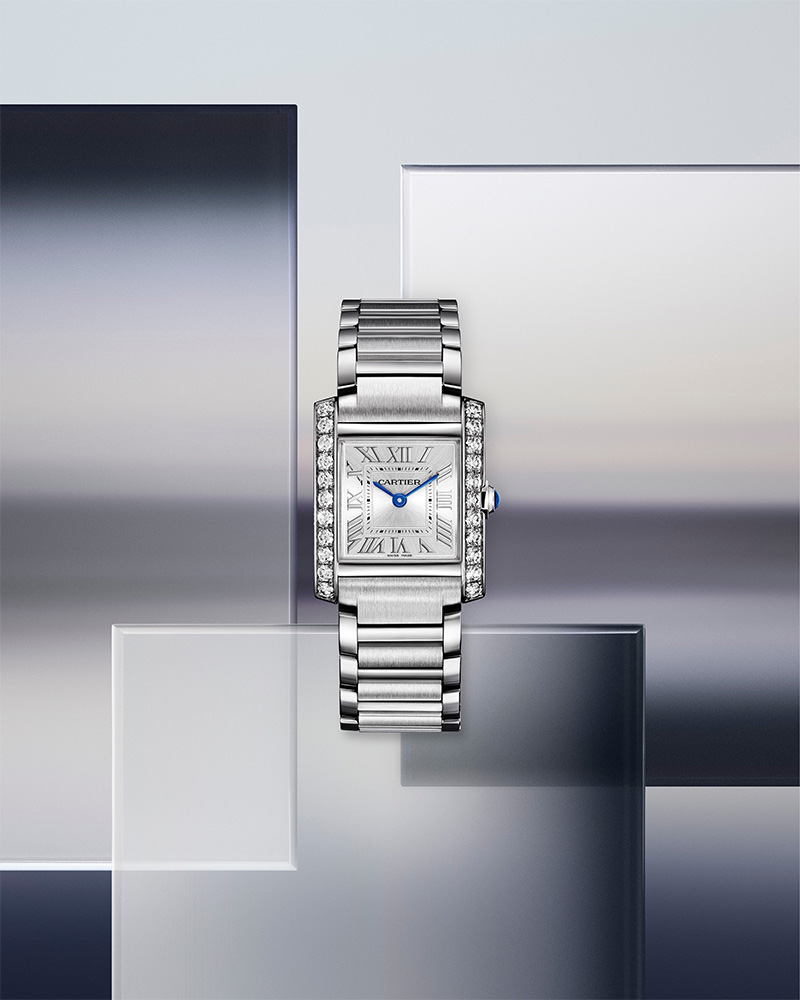
Tank Française
Launched in 1996, the Tank Française debuted, at the time, a metal bracelet in perfect harmony with the case. In 2023, it made a triumphant return, radicalised by Cartier yet true to its monobloc metal design. Its bracelet, whose links fit perfectly together, was revamped by the Maison’s designers to create a curve that was as pure as it was ergonomic, designed for all wrists. The crown was inlaid to match the gentle convex profile of the brancards.
Adopting an innovative approach, Cartier has refined this ultra-streamlined aesthetic to create a steel and diamond version, which features a row of brilliant-cut diamonds highlighting the brancards of the watch. They naturally echo the polished finishes and sunray-brushed dial of this Cartier design icon, equipped with a high autonomy quartz movement.
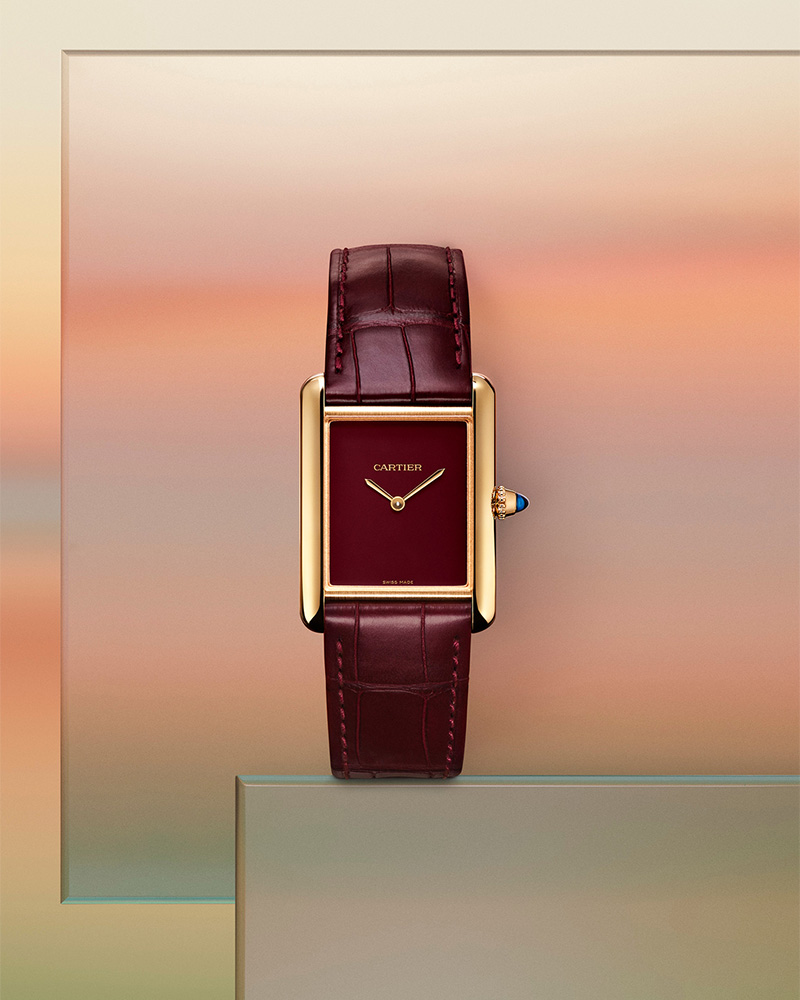
Tank Louis Cartier
In 1921, Louis Cartier reworked the design of the original Tank, the “Tank Normale”. Its case was stretched, brancards refined and edges softened: The Tank LC (for Louis Cartier) watch had arrived.
Today, its pure lines allow for the most audacious feats, such as colour variations or original motifs.
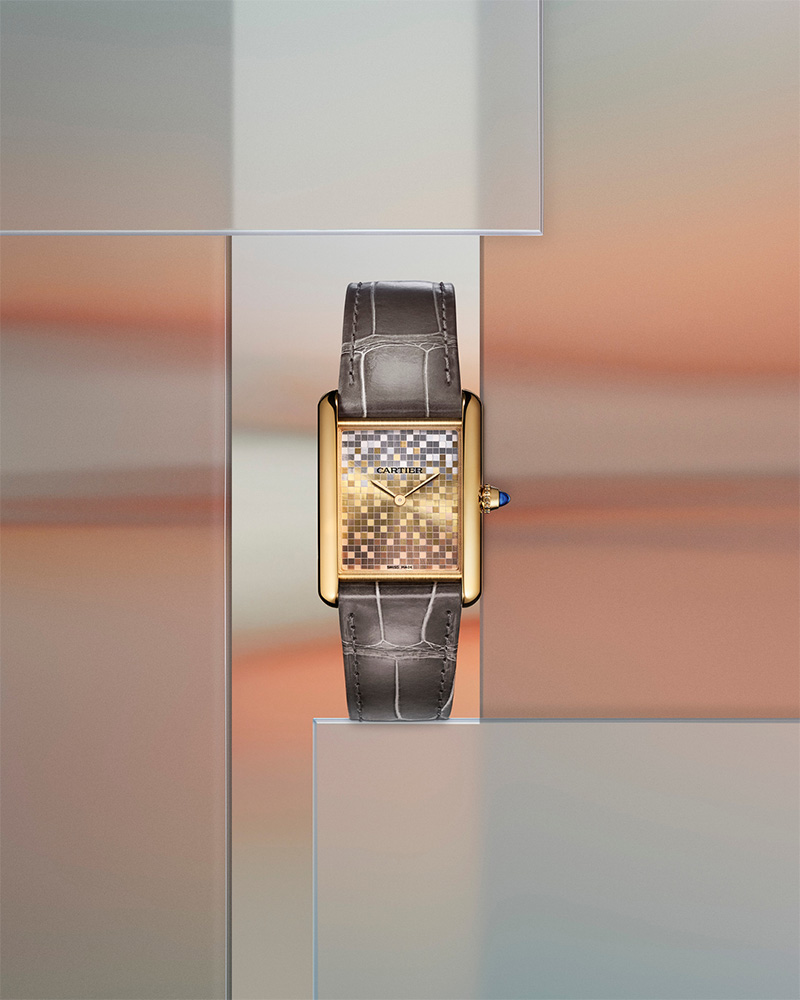
Gold motifs
An unmistakeable signature of Cartier style, geometry and contrasts are the subject of continuous creative research, a field that is now expanding to explore kinetic territories. Playing on echoed elements and mirror constructions, these two versions of the Tank Louis Cartier use graphic motifs in gold, yellow gold, rose gold and white gold—in an homage to the Tank Must dials of the 1970s— to create an optical grid. In yellow or rose gold on an alligator strap, they are all equipped with the 1917 MC movement with manual winding.
Colour variations
With a lacquered burgundy or all-green dial, the Tank Louis Cartier watch frees itself from traditional watchmaking codes and opts instead for elegant simplicity. These yellow gold watches favour minimalist dials, free of any Roman numerals or rail tracks, and a fully chromatic look with matching alligator straps. All of them are equipped with the 1917 MC movement with manual winding.
Discover more Cartier collections at our boutiques, or online.










